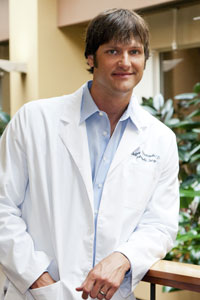Meniscus Injury Specialist

Are you experiencing pain and stiffness in your knee? If so, you may have torn your meniscus. A meniscus tear is among the most common knee injuries. A torn meniscus can occur in several different ways. Meniscus injury specialist, Dr. Jeff Padalecki provides diagnosis and both surgical and nonsurgical treatment options for patients in Austin who have torn their meniscus. Contact Dr. Padalecki’s team today!
What are Meniscus Injuries in the Knee?
Injuries to the meniscus cartilage of the knee are among the most common injuries encountered in sports. A torn meniscus can also occur outside of the sports world and often happen to individuals during activities of daily living in which a pathologic twisting event occurs to the knee. Dr. Jeff Padalecki, orthopedic knee specialist serving patients in Austin, Round Rock, and Cedar Park, Texas communities, specializes in treating patients with a meniscus injury.
To understand this part of the knee, it helps to discuss the anatomy of this region. Three bones form your knee joint:
- Thighbone (femur)
- Shinbone (tibia)
- Kneecap (patella)
Within the joint, there are two tough and rubbery wedge-shaped pieces of cartilage that act as “shock absorbers” between the thighbone and shinbone. This C-shaped cartilage is called the meniscus and also acts as a stabilizer to the knee. A torn meniscus occurs most often in sports during an unnatural twisting or squatting injury to the knee. Older individuals are also more likely to have deficient or degenerative tears in the meniscus as the cartilage in the knee weakens and wears down over time. Seemingly simple movements in the knee may cause a tear as the menisci weaken with age.
What are the Symptoms of a Meniscus Injury?
The most common symptoms of meniscal tears are pain, stiffness, and swelling. People with a meniscus tear may report a feeling of instability or that the knee is going to “give way.” Additionally, some patients may feel a catch or locking sensation in the knee and find that it will not freely move with full range of motion. In many cases, you can still walk with a meniscal tear, but over a few days, the knee will gradually stiffen and become more swollen than when suffering the initial tear. Some people find that they can still do the activities they like to do with a minor meniscus injury but they may have a persistent pain, swelling, or feeling of instability.
How is a Meniscus Injury Diagnosed?
Dr. Padalecki will conduct a thorough examination of the knee and look for any deformities or changes in the appearance of the knee in comparison to the uninjured one. A test often used to check for an injury to the meniscus, is the McMurray test. Dr. Padalecki will bend your knee, then straighten and rotate it. This puts strain and tension on a torn meniscus, and if a tear does exist, then movement will cause a clicking sound. Dr. Padalecki will also check for tenderness along the joint where the meniscus sits, which is often a sign of a tear. Certain tests may be utilized to determine the extent of the injury and Dr. Padalecki is likely to recommend X-rays and an MRI.
What is the Treatment for a Meniscus Injury?
The treatment for a meniscal tear will vary based on the size of the tear and its location within the knee. It is also important to consider your age, activity level, and any associated injuries.
The outside portion of the meniscus has a rich blood supply, and a tear in this area may heal on its own. However, the inner portion of the meniscus lacks a blood supply and cannot heal on its own. Because these tears are often in thin, worn cartilage, tears in this zone are usually surgically trimmed away.
Non-surgical
Some meniscal tears can be treated with a combination of ice, rest, compression and elevation of the knee. Anti-inflammatory medications (NSAIDs) and pain relievers can help alleviate symptoms. Diminished use of the knee for a period of time will help in the healing process.
Surgical
Dr. Padalecki is a strong advocate for meniscus repair and he attempts to preserve the maximum amount of meniscus in his patients when possible. In more severe tears, Dr. Padalecki will conduct an arthroscopic procedure called a meniscectomy to trim out the tear. This approach is less invasive and allows for less pain and a quicker recovery time. He is able to perform this technique arthroscopically which yields very good success rates.
What Occurs After Surgery for a Torn Meniscus?
Patients are often placed in a brace to immobilize the knee for a period of time. Crutches can help minimize the weight placed on the knee. Following surgery, a course of physical therapy will be ordered to focus on returning motion and strength back to the injured knee.
For more information on repair and rehabilitation of a meniscus injury in the knee or any other type of knee related injury, please contact the office of Dr. Jeff Padalecki, knee specialist in Austin, Texas.
